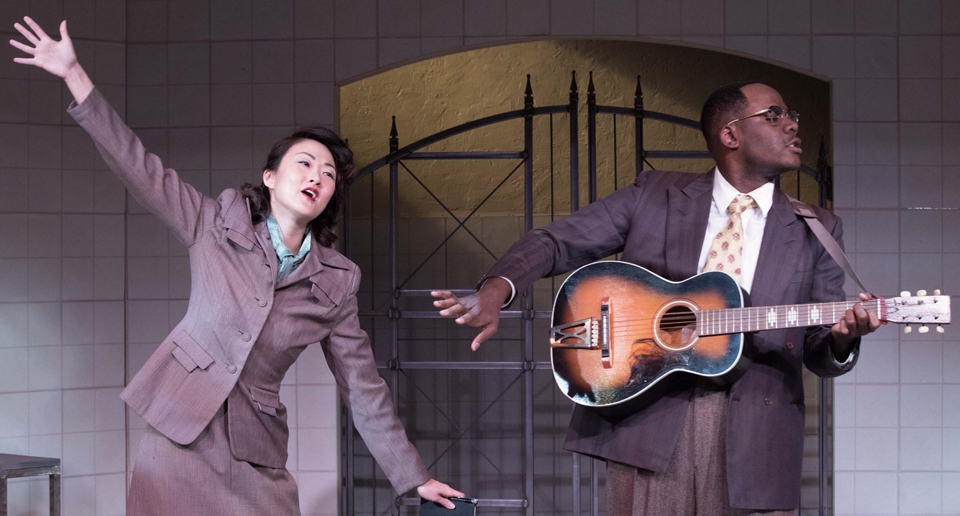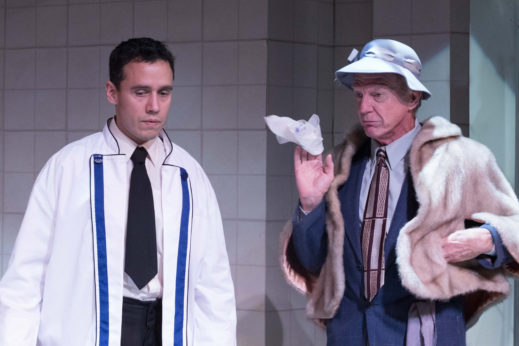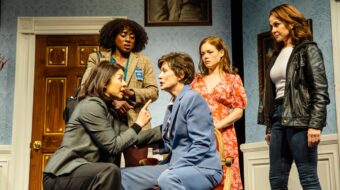
LOS ANGELES—Tom Jacobson’s trilogy of historically based plays “The Ballad of Bimini Baths,” produced in three different theatres in three distinct productions, is shortly approaching the end of its run. Even in so significant a theatre town such as L.A., this trio of works has earned landmark status.
Chronologically the first, Plunge, with two male characters, recounts tragic crimes in the World War I era against underage male adolescents, one of whom, unseen, is the Mexican-American Zenobio Remedios. In play two, Tar, taking place in 1939, on the eve of World War II, Remedios is one of two bathhouse attendants, along with an African-American assistant, who are assigned to clean up a racist white man who had fallen into the La Brea Tar Pits.
The third play is Mexican Day (seen June 22), which takes place in 1948, also at the baths. Remedios (Jonathan Medina) has returned from liberating the Nazi death camps in Europe and is now a front-desk receptionist at the baths, resuming his career there after the wartime hiatus. It is his duty to enforce the policy of admitting whites only to this “exclusive” institution except on the last day of the month, when Mexicans and other racial minorities are allowed to use the pools and plunges before the water is drained and replaced. This third episode is the only two-act play in the series, as there is more ground to cover. It also has the largest cast—four actors—one of whom is a woman. Together they will end once and for all the racial separation policy that up to now has seemed almost divinely ordained.
As John Perrin Flynn, artistic director of Rogue Machine Theatre, says in his program note, “In 1939, nearly half—47 percent—of all Los Angeles County residential neighborhoods had restrictive covenants that forbade certain racial groups from those communities.” Those covenants prevailed even after WW II, and became an often-cited factor in the Ronald Reagan presidential campaign when it came to light that the B actor had signed them on the deeds to homes he bought and sold in L.A.
Aside from Remedios there is one other recurring character—one of the child molesters from Plunge, Everett Maxwell (Darrell Larson), a historical figure who long ago served his one-year sentence at San Quentin but has remained a social outcast ever since. Recuperation and rehabilitation have come at great personal cost, and he never dared show his face again at the Bimini Baths.
Enter the crusading civil rights activist, the gay African-American Bayard Rustin (Donathan Walters), who had spent two of the war years at Lewisburg Federal Penitentiary for being a conscientious objector. Now on assignment from an East Coast pacifist organization called the Fellowship of Reconciliation, run by the Rev. A.J. Muste, Rustin has come to L.A. to end the scourge of racial discrimination at the baths. For Rustin, of course, there is a frisson of sexual as well as racial liberation, the bath house being a common locale for same-gender, often anonymous hook-ups.
Seeking potential allies for his campaign, Rustin visits the offices of a Black-owned newspaper in town, the Los Angeles Tribune, where he meets one of the staff writers, Hisaye Yamamoto (Jully Lee), another historical figure, who is intrigued by Rustin’s plan but is constrained by the newspaper’s firm policy to report, but not make the news. In her own experience she was interned in a wartime concentration camp for Japanese Americans, and her brother was killed in action in Italy. For her, “this all-American war is not over.”
There are a few other minor characters in the play, but these are portrayed by the four actors in different costumes and voices, further jumbling up our sense of racial and even gender exclusivities.
Each of the characters has their struggles and contradictions to overcome: Zenobio, his enforcement of a racist policy that discriminates against his own people, and one also gets the feeling that his sexuality may have been permanently thwarted from being raped at the age of thirteen. Maxwell, his slow recovery into modest respectability as an art historian and film script writer, which he would not wish to jeopardize by going public on the bath house policy. Rustin, who must be discreet about his own sexuality while being attracted to both Zenobio and—perhaps self-interestedly—the older Maxwell too in order to recruit a white person to the campaign. And Yamamoto, who recognizes the ongoing racism of America yet who doesn’t want to lose her staff position at the paper—and because of a troubling sexual incident that occurred during her internment, she is awkward around men.
People go to a bath house to get clean (among other reasons), and each of these four characters has their own issues to wash out.

They all have their commonalities as well: Ostracism, exclusion, prejudice, rejection, banning, all have indelibly stamped their lives. And each has their own turf to defend as well. For example, when Yamamoto proposes that she write an article on Zenobio’s predicament in his “lackey” job at the baths, he angrily responds, “It’s my lackey job. You can’t write me.” Yamamoto knows that as a writer surely she should be able to convey some understanding of other types of people than the Japanese-American woman that she is.
Jacobson subtly incorporates references to the two previous plays. I felt truly saddened to learn that the (fictional) Shakespeare-quoting African-American attendant Amen in Tar had been drafted into the military and was killed in the infamous 1944 Port Chicago incident—another victim of American racism in our segregated military while our country was battling Aryan racial supremacy overseas.
Act two centers around the several days-long sit-in in the lobby of the baths, Rustin with his guitar singing the “Ballad of Bimini Baths” in an oblique reference to the re-emergence of the folk music and topical song tradition in the 1940s. It’s the kind of song that might have appeared in Sing Out! or Broadside. When the cops are called to evict the “goddam Communist” protesters, it’s the Irish cop who determines that they’re not doing anything wrong—recalling historic anti-Irish prejudice in the U.S.
In another reference to the concerns of the era, Remedios insists that Rustin and Yamamoto cannot enter because they don’t have health certificates—which he does not demand of anyone else, of course—reminding us that polio was a frightening fact of life in those pre-vaccine days.
There is a touching confrontation between Maxwell and Remedios, who surprisingly re-encounter one another after 32 years. Repentant as Maxwell is, Remedios replies “My life didn’t stop with you. I’ve seen much worse in the world. I grew up.” The meeting has a healing quality for both men.
Victory is achieved. Now every day is Mexican Day. The fearsome foursome—Mexican American, African American, Japanese American, and white American—have not broken the law but changed the law. And they have changed themselves in the process. As they join hands and jump into the plunge together, they address the audience saying, “It’s your story.” And indeed it is, for all of us.
Jacobson uses a technique in this play, that I did not notice in the other two, of characters speaking their internal thoughts aloud, almost as stage directions, things like “He smiled faintly and turned away,” as the character, uh, smiled faintly and turned away. I found most of this business affected and unnecessary. A small complaint, but after the first few incidents of it, each time he resorted to it I wondered why he felt so attached to this conceit.
Jeff Liu directed, with touches of humor especially as the ancillary characters marched through with their costumes and props. The scenic design by John Iacovelli captured the essence of the bath house, while two turntables on stage allowed for a variety of other environments to appear—the newspaper office, hotel room, bars. Effective lighting for all these different environments came from the hands of Brian Gale, and the varied 1940s costumes came from Dianne E. Graebner.
It was a gift to experience this trilogy in all its historical, cultural and artful depth, in theatres only blocks away from the original location of the Bimini Baths (which closed in 1951). We see plays all the time set in far-off places we may never visit, yet I wonder if it would be hard to work up enthusiasm outside of L.A. for this admittedly challenging project. I can only hope theatre companies in other cities take a leap with these plays, whose themes resonate far beyond the confines of Southern California. Maybe they could schedule the trilogy on weekends so that audiences can see all three in one day with a dinner break (they’re not long, the first two only an hour or so, and the third maybe two, with intermission). That way busy culture vultures would not have to trek out three nights. And a single production crew on one stage, instead of three, would save on expense.
A video about the production can be viewed here.
Mexican Day has been extended through July 15 (with no performance on July 14 however), Fri. at 8:00 pm, Sat. at 4:00 pm, and Sun. at 8:00 pm. For tickets to the two remaining plays in the trilogy, see here.

MOST POPULAR TODAY


Zionist organizations leading campaign to stop ceasefire resolutions in D.C. area

High Court essentially bans demonstrations, freedom of assembly in Deep South

Afghanistan’s socialist years: The promising future killed off by U.S. imperialism

Communist Karol Cariola elected president of Chile’s legislature






Comments